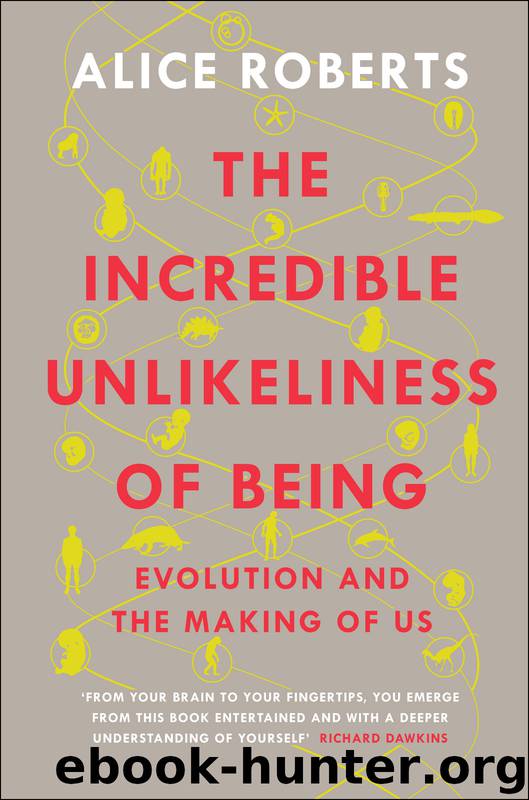The Incredible Unlikeliness of Being by Alice Roberts

Author:Alice Roberts [Roberts, Alice]
Language: eng
Format: epub
Publisher: Quercus Publishing
Published: 2014-09-03T23:00:00+00:00
NEANDERTHAL CHESTS
While the shape of your chest reflects your posture and how you move (as an ape with an upright trunk, which doesn’t hang around in trees any more, and which tends to swing its arms as it walks), it also tells us something more general about your way of life. Or at least, the size of your chest tells us something. And that ‘something’ emerges when we compare ourselves with the closest of our closest extinct relations: Neanderthals.
The most complete Neanderthal ribcage to date comes from the Kebara ‘K2’ specimen – the same partial skeleton which included the Neanderthal hyoid bone we met earlier in the Speech and Gills chapter. Incredibly, the K2 thorax comprises fragments of every rib, and so, compared with the debates over the few bits and pieces of ribcages of earlier hominins, this leaves much less room for doubt about the shape of a Neanderthal chest.
Looking at Neanderthal bones, I am always struck by just how chunky and robust they are compared with modern human bones. Even the stockiest Anglo-Saxon skeleton looks weedy in comparison with a Neanderthal. Each bone in the body (apart from, rather strangely, the clavicle, which is extremely long and thin) is like a supersized version of the modern human equivalent. The shape of the whole skeleton, put together, is also sturdy. The ribcage looks massive. In comparison with ribs in modern human populations, the K2 ribs are larger – in absolute terms and relative to stature. Long ribs like these mean that the volume of the Neanderthal chest must have been larger than that of modern humans. But because even these well-preserved Neanderthal ribs have suffered some warping since becoming buried in the ground, it’s difficult to be sure about whether that increase in volume resulted from a front-to-back expansion of the chest, or a widening. Someone needs to find some undistorted Neanderthal ribs to answer that question.
Nevertheless, even with slightly warped ribs, it’s clear that the Neanderthal chest was not only larger, but a different shape to ours. The uppermost and lowermost ribs are a similar size to those in the chest of a modern man, but the middle ribs are much larger. If the modern human chest is classically described as barrel-shaped, then the Neanderthal chest is ‘hyper-barrel-shaped’ – much broader in the middle. It seems likely that a large chest would have meant large lungs (although even this is far from certain, as the position of the diaphragm and how far it domes up into the chest has a very large influence on lung volume). Having said that, among modern humans at least, a large chest does mean large lungs inside it. Indigenous people living in the high Andes today tend to have large chest circumferences, and large lungs inside those chests.
Neanderthals have often been described as being ‘cold-adapted’, and it’s been suggested that their large chests and lungs were just such an adaptation. However, there seems good reason to believe – even in the absence of
Download
This site does not store any files on its server. We only index and link to content provided by other sites. Please contact the content providers to delete copyright contents if any and email us, we'll remove relevant links or contents immediately.
| Fossils | Game Theory |
| Genetics | Molecular Biology |
| Organic | Paleontology |
Sapiens: A Brief History of Humankind by Yuval Noah Harari(14319)
Sapiens by Yuval Noah Harari(5322)
Pale Blue Dot by Carl Sagan(4953)
Homo Deus: A Brief History of Tomorrow by Yuval Noah Harari(4871)
Livewired by David Eagleman(3729)
Origin Story: A Big History of Everything by David Christian(3666)
Brief Answers to the Big Questions by Stephen Hawking(3392)
Inferior by Angela Saini(3293)
Origin Story by David Christian(3170)
Signature in the Cell: DNA and the Evidence for Intelligent Design by Stephen C. Meyer(3098)
The Gene: An Intimate History by Siddhartha Mukherjee(3074)
The Evolution of Beauty by Richard O. Prum(2963)
Aliens by Jim Al-Khalili(2802)
How The Mind Works by Steven Pinker(2776)
A Short History of Nearly Everything by Bryson Bill(2659)
Sex at Dawn: The Prehistoric Origins of Modern Sexuality by Ryan Christopher(2500)
From Bacteria to Bach and Back by Daniel C. Dennett(2462)
Endless Forms Most Beautiful by Sean B. Carroll(2442)
Who We Are and How We Got Here by David Reich(2417)
